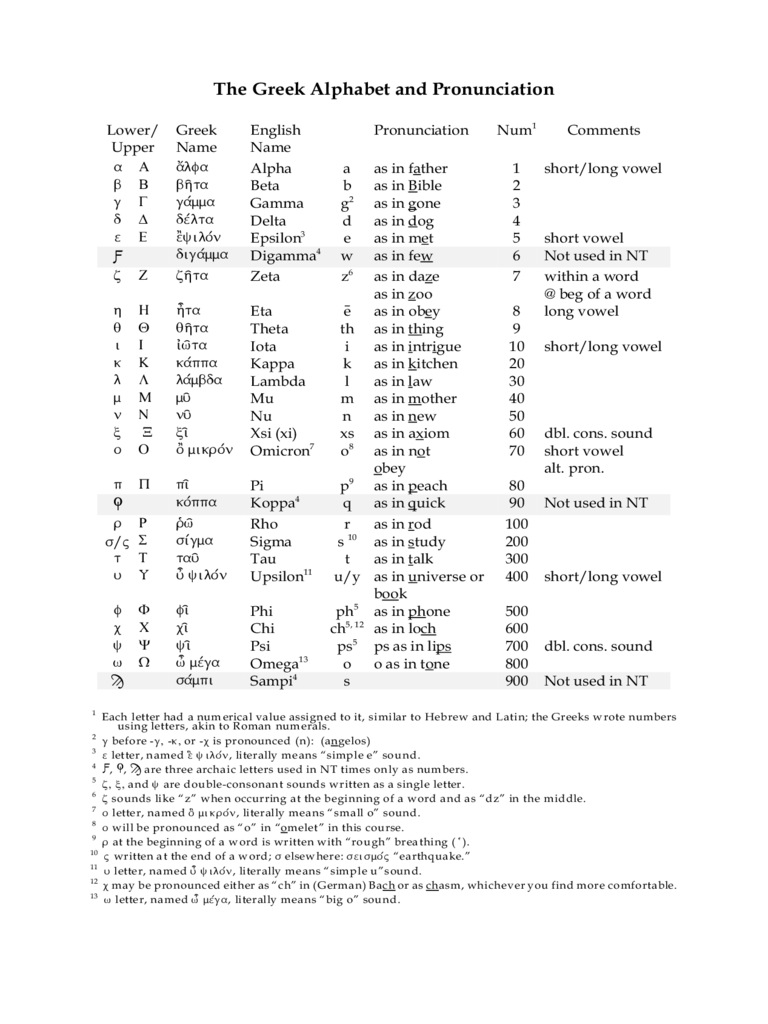Fillable Printable The Greek Alphabet and Pronunciation Chart
Fillable Printable The Greek Alphabet and Pronunciation Chart

The Greek Alphabet and Pronunciation Chart

The Greek Alphabet and Pronunciation
Lower/
Upper
Greek
Name
English
Name
Pronunciation Num
1
Comments
a A a!lfa
Alpha a as in father 1 short/long vowel
b B bh'ta
Beta b as in Bible 2
g G gavmma
Gamma g
2
as in gone 3
d D devlta
Delta d as in dog 4
e E e]yilovn
Epsilon
3
e as in met 5 short vowel
ú
digavmma
Digamma
4
w as in few 6 Not used in NT
z Z zh'ta
Zeta z
6
as in daze
as in zoo
7 within a word
@ beg of a word
h H h^ta
Eta e2 as in obey 8 long vowel
q Q qh'ta
Theta th as in thing 9
i I ijw'ta
Iota i as in intrigue 10 short/long vowel
k K kavppa
Kappa k as in kitchen 20
l L lavmbda
Lambda l as in law 30
m M mu'
Mu m as in mother 40
n N nu'
Nu n as in new 50
x X xi'
Xsi (xi) xs as in axiom 60 dbl. cons. sound
o O o] mikrovn
Omicron
7
o
8
as in not
obey
70 short vowel
alt. pron.
p P pi'
Pi p
9
as in peach 80
û
kovppa
Koppa
4
q as in quick 90 Not used in NT
r R rJw'
Rho r as in rod 100
s/"
S sivgma
Sigma s
10
as in study 200
t T tau'
Tau t as in talk 300
u U u^ yilovn
Upsilon
11
u/y as in universe or
book
400 short/long vowel
f F fi'
Phi ph
5
as in phone 500
c C ci'
Chi ch
5, 12
as in loch 600
y Y yi'
Psi ps
5
ps as in lips 700 dbl. cons. sound
w W w^ mevga
Omega
13
o o as in tone 800
ü
savmpi
Sampi
4
s 900 Not used in NT
1
Each letter had a numerical value assigned to it, similar to Hebrew and Latin; the Greeks wrote numbers
using letters, akin to Roman numerals.
2
g before -g, -k, or -c is pronounced (n): (angelos)
3
e letter, named e} yilovn, literally means “simple e” sound.
4
ú, û, ü are three archaic letters used in NT times only as numbers.
5
z, x, and y are double-consonant sounds written as a single letter.
6
z sounds like “z” when occurring at the beginning of a word and as “dz” in the middle.
7
o letter, named o} mikrovn, literally means “small o” sound.
8
o will be pronounced as “o” in “omelet” in this course.
9
r at the beginning of a word is written with “rough” breathing ( J).
10
" written at the end of a word; s elsewhere: seismov" “earthquake.”
11
u letter, named u^ yilovn, literally means “simple u”sound.
12
c may be pronounced either as “ch” in (German) Bach or as chasm, whichever you find more comfortable.
13
w letter, named w^ mevga, literally means “big o” sound.

Vowels, Diphthongs & Diacritical Marks
I. Vowels
A. There are seven vowel letters with ten vowel sounds (long vowels are marked with “2” above);
B. Vowels are “paired”: short and long (e.g., short a with long a2)
English
Vowel
Greek
Short Pronunciation
Greek
Long Pronunciation Formation
a
a
“a” as in father
a2
same as short open
e
e
“e” as in get
h
e as in grey open
i
i
“i” as in pin
i2
“i” as in marine close
o
o
“o” as in omelet
w
o as in note open
u
u
“u” as in flute
u2
same as short close
II. Diphthongs:
A. “Diphthong” comes from two Greek words: di — “two” + fqovgg-o" — “sounds”;
B. A diphthong refers to a single syllable that is composed of two vowels;
C. The second letter is always a “close” vowel (i, u)
Diphthong Pronunciation Diphthong Pronunciation
vowel + i vowel + u
ai
ai as in aisle
au
au as in Germ. Sauerkraut
ei
ei as in freight
eu
eu as in Eucharist at the beginning of a word
oi
oi as in oil ou as in soup within a word
ui
ui as in suite
ou
ou as in soup
rarely occur
hu
a as in grey + u as in Germ. Gru@ n (run the two
sounds together)
wu
o as in note + u as in Germ. Gru@n (run the two
sounds together)
III. Diacritical Marks
A. Breathing: occurs with vowels or diphthongs at the beginning of a word:
1. Smooth ( j) points away from the word; vowel/diph. has a normal sound.
2. Rough ( J) points towards the word; the vowel/diph. Is preceded by an “h” sound.
B. Accent: occurs with vowels or diphthongs to indicate word stress
1. Acute ( v) can occur on any one of the last three syllables;
2. Circumflex ( ') can occur on either one of the last two syllables;
3. Grave ( V) can occur only on the last syllable.
C. Iota Subscript: a, h, or w can combine with i to form a single letter:
1. i is written below and does not affect the pronunciation: a/, h/, w/.
D. Diaeresis: (@) indicates two adjacent vowels are pronounced separately, e.g. jHsai>a".
IV: Punctuation:
A. Comma (,): looks just like an English one. , = ,
B. Period (.): looks just like an English one. . = .
C. Semicolon (:): written s a period above the line. ; = :
D. Question Mark (;): looks like an English semicolon. ? = ;
E. Apostrophe ( j): looks like an English one but is used to indicate “elision”
(when a word’s final vowel drops before next word beginning with a vowel. ajll j i{na



